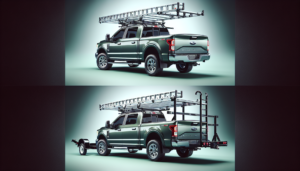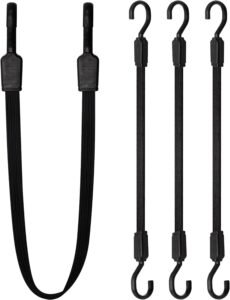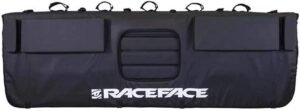Are you wondering about the distinctions between a side-mount ladder rack and an overhead ladder rack? Well, let’s break it down for you. The main dissimilarity lies in their positioning on the vehicle. A side-mount ladder rack is attached to the side of the vehicle, providing easy access to the ladder. On the other hand, an overhead ladder rack is installed above the vehicle, securely holding the ladder in place. Each has its own advantages and considerations, depending on your specific needs. So, let’s delve deeper into these two types of ladder racks and explore their features and benefits.
Definition of a Side-mount Ladder Rack
Overview
A side-mount ladder rack is a device that is designed to securely hold ladders on the side of a vehicle. It is typically installed on the exterior of a truck or van, providing easy access to ladders while optimizing space. This type of ladder rack is commonly used by professionals in various industries, such as construction, maintenance, and transportation.
Design and Installation
Side-mount ladder racks are usually made of durable materials like steel or aluminum to ensure strength and longevity. They are specifically designed to withstand the weight and size of ladders, providing a secure and stable mount. Installation methods may vary depending on the specific rack, but they generally involve attaching the rack to existing anchor points or drilling into the vehicle’s body.
Primary Functions of a Side-mount Ladder Rack
Securing Ladders
The primary function of a side-mount ladder rack is to securely hold ladders in place during transportation. These racks are equipped with mechanisms such as straps, hooks, or clamps that effectively secure the ladder, preventing it from sliding or falling off the vehicle. This ensures the safety of both the ladder and the occupants of the vehicle.
Accommodating Different Ladder Sizes
One of the key advantages of a side-mount ladder rack is its ability to accommodate ladders of various sizes. The design of the rack allows for flexibility in terms of ladder length and width, making it suitable for different types of ladders. This versatility is particularly beneficial for professionals who work with a range of ladder sizes in their daily tasks.
Optimizing Space
Another important function of a side-mount ladder rack is its ability to optimize space on the vehicle. By mounting the ladder on the side, it frees up valuable space inside the vehicle that can be used to carry other equipment or tools. This not only maximizes the storage capacity but also allows for easy access to stored items without the need to crawl over or remove the ladder.
Benefits of a Side-mount Ladder Rack
Easy Access
One of the significant benefits of a side-mount ladder rack is the easy accessibility it provides. With the ladder mounted on the side of the vehicle, you can quickly and conveniently retrieve or load the ladder without the need for additional assistance. This saves time and effort, especially when working on tight schedules or in situations that require immediate access to the ladder.
Increased Safety
Safety is always a top priority, especially when it comes to transporting ladders. A side-mount ladder rack enhances safety by securely holding the ladder in place, minimizing the risk of it falling off during transit. This reduces the chances of accidents or injuries caused by unsecured ladders on the road. Additionally, a properly installed ladder rack improves the overall stability of the vehicle, ensuring a safer driving experience.
Versatility
The versatility of a side-mount ladder rack is a significant advantage for professionals who work with different types of ladders. Whether you need to transport extension ladders, step ladders, or any other variation, a side-mount ladder rack can accommodate them all. This eliminates the need for multiple racks or storage solutions, making it a cost-effective and space-saving choice.
Considerations for Using a Side-mount Ladder Rack
Weight Limitations
It is essential to consider the weight limitations of a side-mount ladder rack before loading it with ladders. Each rack has a maximum weight capacity, so it is crucial to ensure that the total weight of the ladders does not exceed this limit. Overloading the rack can compromise its stability and make it unsafe for transportation.
Potential Obstruction
While a side-mount ladder rack offers easy access to the vehicle’s interior, it is important to consider the potential obstruction it may present. The presence of the ladder on the side of the vehicle may restrict visibility from certain angles, especially when driving or parking in tight spaces. It is essential to be mindful of this limitation and adjust driving habits accordingly.
Installation Requirements
Before purchasing a side-mount ladder rack, it is crucial to consider the installation requirements and compatibility with your vehicle. Some racks may require drilling into the vehicle’s body, which can affect its structural integrity. It is advisable to consult with professionals or follow the manufacturer’s instructions to ensure proper installation and avoid any damage to the vehicle.
Definition of an Overhead Ladder Rack
Overview
An overhead ladder rack is a type of rack that is installed on the roof of a vehicle, allowing ladders to be carried and transported securely. It is commonly used by professionals who require frequent access to their ladders and need to maximize the storage capacity of their vehicle. The overhead position of the rack offers several advantages in terms of space management and convenience.
Design and Installation
Overhead ladder racks are typically constructed from robust materials such as steel or aluminum to ensure durability and withstand the weight of the ladders. They are specifically designed to be mounted on the roof of the vehicle, typically utilizing existing roof rails or anchor points. Installation may require some drilling or modification of the vehicle’s roof, so it is essential to follow the manufacturer’s instructions for proper installation.
Primary Functions of an Overhead Ladder Rack
Maximizing Storage Capacity
One of the primary functions of an overhead ladder rack is to maximize the storage capacity of the vehicle. By utilizing the roof space, it frees up valuable interior space for other equipment or cargo. This is especially beneficial for professionals who need to carry additional tools or materials along with their ladders, providing them with a more efficient and organized workspace.
Safe Transportation
An overhead ladder rack ensures the safe transportation of ladders by securely holding them on the roof of the vehicle. The rack is designed with straps, clamps, or other securing mechanisms that prevent the ladders from shifting or falling during transit. This eliminates the risk of accidents or damage to the ladders, as well as minimizing any potential hazards caused by unsecured loads on the road.
Easy Loading and Unloading
Another significant function of an overhead ladder rack is its ability to facilitate easy loading and unloading of ladders. The roof position of the rack allows for convenient access to the ladders without the need to bend or lift heavy objects from ground level. This is particularly advantageous for professionals who frequently load and unload ladders throughout the day, reducing strain and minimizing the risk of injuries.
Benefits of an Overhead Ladder Rack
Efficient Space Management
Optimizing space is a crucial benefit of an overhead ladder rack. By utilizing the roof area, the rack allows you to carry ladders without sacrificing space in the vehicle’s interior. This increased storage capacity enables you to carry more equipment or supplies, improving efficiency and productivity. It also keeps the vehicle organized and clutter-free, making it easier to locate and access items when needed.
Increased Accessibility
The overhead position of the ladder rack enhances accessibility to the ladders. With the rack situated on the roof, you can quickly retrieve or load ladders without any obstructions or limitations. This easy accessibility is particularly advantageous when working in busy job sites or confined spaces, where quick and convenient access to ladders is essential.
Reduced Risk of Damage
Carrying ladders on the roof, away from the vehicle’s body, reduces the risk of damage to the vehicle. While accidents can still happen, an overhead ladder rack minimizes the chances of scratches, dents, or other cosmetic damages caused by the ladders coming into contact with the vehicle’s surface. This helps to maintain the vehicle’s appearance and value, especially for those who use their vehicles for professional purposes.
Considerations for Using an Overhead Ladder Rack
Vehicle Height Restrictions
One of the primary considerations when using an overhead ladder rack is the height restrictions it may impose on the vehicle. The added height of the ladders on the roof can limit access to low-clearance areas, such as underground parking garages or drive-thru entrances. It is important to be aware of these restrictions and plan routes accordingly to avoid any potential damage or inconvenience.
Weight Distribution
Proper weight distribution is crucial when using an overhead ladder rack. Placing all the weight on the roof of the vehicle can significantly affect its stability and handling, especially during turns or sudden maneuvers. It is essential to evenly distribute the load and adhere to the weight limits specified by the manufacturer. This ensures a balanced and safe driving experience while minimizing the risk of accidents or damage.
Installation Complexity
The installation of an overhead ladder rack can be more complex compared to a side-mount ladder rack. It may involve drilling or modifying the vehicle’s roof, which requires precise measurements and proper alignment. It is highly recommended to consult with professionals or follow the manufacturer’s instructions to ensure a secure and accurate installation. Improper installation can lead to damage to the vehicle or compromised stability of the rack.
Comparison of Side-mount and Overhead Ladder Racks
Design and Installation
Both side-mount and overhead ladder racks are designed to securely hold ladders, but they differ in their placement and installation. Side-mount ladder racks are installed on the side of the vehicle, utilizing existing anchor points or through drilling, while overhead ladder racks are mounted on the roof, typically utilizing roof rails or anchor points. The installation complexity may vary depending on the specific rack and vehicle compatibility.
Space and Accessibility
In terms of space and accessibility, side-mount ladder racks optimize space within the vehicle by mounting the ladder on the side. This frees up valuable interior space and provides easy access to stored items. On the other hand, overhead ladder racks maximize storage capacity by utilizing the roof area, allowing for easy loading and unloading of ladders without obstructions.
Weight Capacity
Both side-mount and overhead ladder racks have weight limitations. It is important to consider these limitations and ensure that the total weight of the ladders does not exceed the rack’s capacity. Overloading either rack can compromise stability and safety during transportation.
Vehicle Compatibility
When choosing between side-mount and overhead ladder racks, it is important to consider the compatibility with your vehicle. Not all vehicles can accommodate both types of racks, and some may require additional modifications for proper installation. It is advisable to consult with professionals or refer to the manufacturer’s guidelines to ensure compatibility and avoid any damage to the vehicle.
Which Ladder Rack is Right for You?
Consider Your Needs and Preferences
Choosing the right ladder rack depends on your specific needs and preferences. Consider the types and sizes of ladders you use regularly, the accessibility required, and the amount of storage space needed. Identifying your specific requirements will help narrow down the options and choose a ladder rack that best suits your needs.
Evaluate Vehicle Type and Daily Usage
The type of vehicle you have and its intended usage play a crucial role in determining the appropriate ladder rack. Consider the height restrictions, weight capacity required, and the impact on the vehicle’s handling. Additionally, evaluate your daily usage and the frequency of loading and unloading ladders. This will help determine whether a side-mount or overhead ladder rack will provide the most convenience and efficiency.
Consult with Professionals
If you’re unsure about which ladder rack to choose or have specific concerns regarding your vehicle, it is always beneficial to consult with professionals. They can provide expert advice, suggest suitable options based on your requirements, and ensure proper installation for optimal safety and functionality. Consulting with professionals ensures that you make an informed decision and select a ladder rack that meets all your needs.
In conclusion, both side-mount and overhead ladder racks provide secure and convenient ways to transport ladders. The choice between the two depends on various factors such as accessibility, space optimization, weight capacity, and vehicle compatibility. By considering your specific needs, evaluating your vehicle type and daily usage, and seeking professional advice when needed, you can determine the most suitable ladder rack for your requirements. Ultimately, the right ladder rack will enhance safety, efficiency, and productivity in your professional tasks while ensuring the protection of your ladders and vehicle.






